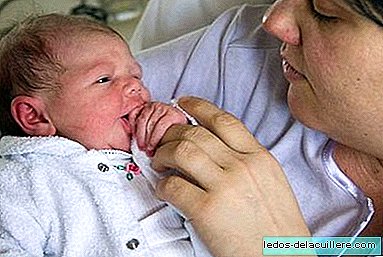Childbirth is one of the most important and transcendental moments in a woman's life, so much so that what happens during it is recorded in the brain of both: mother and baby. Currently, there is more talk every day about humanized deliveries and caesarean sections and about respect the rights of mothers when their babies are born.
Now, The World Health Organization (WHO) has published new recommendations for childbirth, in which the mother is placed in the center for a better experience during childbirth.
Through a statement on its website, WHO announced the publication of a new guide with 56 recommendations and suggestions for a positive birth experience. With it, it seeks to establish worldwide standards of care for pregnant women and reduce the number of unnecessary medical interventions.
According to the information in the statement, it is estimated that 140 million births occur every year in the world, and fortunately, most of them occur without any complications for both mothers and their babies. But nevertheless, in the last 20 years the use of interventions that were previously only performed to avoid or treat certain complications has increased, such as the use of oxytocin to accelerate labor or the number of caesarean, which continues to grow day by day.
AdvertisingDr. Princess Nothemba Simelela, who is the WHO Assistant Director General in the area of Family, Women, Children and Adolescents, comments that the increase in all these medical interventions and that are not necessary, undermine the woman's ability to give birth and negatively affect her birth experience. "If the delivery is progressing normally, and both the mother and her baby are in good condition, it is not necessary to receive any additional intervention to accelerate labor," he said in the statement.
The new WHO guidelines for a positive birth experience

There are 56 new WHO recommendations in total, and they were published in a PDF booklet that is currently available only in English. In them, it is evident the importance of the mother being at the center of decision making for a better experience during and after childbirth.
WHO's suggestions are divided into five blocks: Care during labor and birth, First phase of labor, Second phase of labor, Third phase of labor and Care of the newborn. In each of them, the title, description and category of the guidelines are included, that is, whether or not they are recommended.
In the first block of Care during labor and birth, for example, is included respectful maternal care, maintain effective communication between the medical staff and the mother, as well as the choice of a companion to accompany her during the delivery:
1.- Maternal respectful care is recommended, which refers to organized and provided care for all women in a way that maintains their dignity, privacy and confidentiality, ensures physical integrity and appropriate treatment and allows for an informed decision. and receive ongoing support during labor and delivery.
2.- Effective communication between caregivers and women in labor is recommended through the use of simple and culturally acceptable methods.
3.- The accompaniment of women during labor and delivery by the person of their choice is recommended.
4.- Models of care continuity driven by midwives - consisting of a known midwife or a small group of known midwives providing support to a woman throughout the continuum of prenatal, postnatal and during delivery services - are recommended for pregnant women in settings where effective midwifery programs exist.
In the second block, which covers the first phase of labor, it is mentioned that mothers should be informed that there is no established standard duration of the first phase of labor, as this may vary from woman to woman. In addition, the WHO now recognizes that the referent who indicated that "normal" was that the cervix will expand one centimeter every hour is inaccurate and unreal, and that it is not recommended to take it as a reference to know if a birth is progressing normally:
5.- The use of the following definitions of the latent and active phases of the dilation period is recommended for practice.
- The latent phase of the dilation period is a period characterized by painful uterine contractions and variable changes of the cervix, even with a certain degree of erasure and slower progression of the dilation up to 5 cm for the first labor and delivery. subsequent.
- The period of active dilation is a period characterized by painful and regular uterine contractions with a significant degree of erasure and faster dilation of the cervix from 5 cm to total dilation for the first and subsequent labor .
6.- Women should be informed that a standard duration of the latent phase of the dilation period has not been established and that it can vary widely from one woman to another. However, the duration of the active phase of the period of active dilation (from 5 cm to total dilation of the cervix) generally does not exceed 12 hours in the first deliveries and usually does not exceed 10 hours in the subsequent deliveries.
7.- For pregnant women with spontaneous labor onset, the cervical dilation speed threshold of 1 cm per hour during the active phase of the dilation period (as shown in the alert line of the childbirth) is not It is necessary to identify women who are at risk of suffering adverse labor outcomes and, therefore, it is not recommended for this purpose.
8.- A minimum cervical dilation speed of 1 cm per hour during the entire active phase of the dilation period is irreversibly fast for some women and, therefore, is not recommended to identify a normal progression of labor. A cervical dilation speed less than 1 cm per hour should not be a routine indicator for obstetric intervention.
9.- It is possible that the labor does not accelerate naturally until reaching a threshold of dilation of the cervix of 5 cm. Therefore, the use of medical interventions to accelerate labor and birth (such as stimulation with oxytocin or caesarean section) before this threshold is not recommended, provided that the good conditions of the fetus and the mother are ensured.
10.- For healthy pregnant women with spontaneous labor, a policy of delaying admission to the pre-hospital ward until the period of active dilation is recommended, only in the context of rigorous research.
11.- Routine clinical pelvimetry is not recommended at admission for delivery in healthy pregnant women.
12.- Routine cardiotocography is not recommended for the evaluation of the well-being of the fetus at the time of delivery for healthy pregnant women who have spontaneous labor.
13.- Auscultation is recommended using a Doppler ultrasound device or Pinard stethoscope to assess the well-being of the fetus at the time of delivery.
14.- Routine pubic or perineal shaving is not recommended before vaginal delivery.
15.- It is not recommended to perform enemas to reduce the use of labor delivery.
16.- It is recommended to perform a vaginal touch at four-hour intervals for routine assessment and identification of the prolongation of active labor.
17.- Continuous cardiotocography is not recommended to evaluate the well-being of the fetus in healthy pregnant women with spontaneous labor.
18.- Intermittent auscultation of the fetal heart rate is recommended either by a Doppler ultrasound device or a Pinard stethoscope for healthy pregnant women in labor.
19.- Peridural anesthesia is recommended for healthy pregnant women who request pain relief during labor, depending on the woman's preferences.
20.- Parenteral administration opioids, such as phenathyl, diamorphine and pethidine, are recommended options for healthy pregnant women who request pain relief during labor, depending on the woman's preferences.
21.- Relaxation techniques, including progressive muscle relaxation, breathing, music, mindfulness meditation and other techniques, are recommended for healthy pregnant women who request pain relief during labor, depending on the woman's preferences .
22.- Manual techniques, such as massages or application of warm compresses, are recommended for healthy pregnant women who request pain relief during labor, depending on the woman's preferences.
23.- Pain relief is not recommended to avoid and reduce the use of conduction in labor.
24.- For women with low risk, the intake of liquids and food during labor is recommended.
- It is recommended to encourage mobility and adopt an upright position during labor in low-risk women.
26.- Routine vaginal irrigation with chlorhexidine is not recommended during labor to prevent infections.
27.- It is not recommended to apply a package of care for the active management of labor for the prevention of labor delay.
28.- The isolated use of amniotomy is not recommended to prevent delay in labor.
29.- The early use of amniotomy with early oxytocin conduction for the prevention of labor delay is not recommended.
30.- The use of oxytocin is not recommended for the prevention of labor delay in women undergoing peridural analgesia.
31.- The use of antispasmodics is not recommended for the prevention of delayed labor.
32.- The use of intravenous fluids is not recommended to shorten the duration of labor.
The third block, corresponding to the second phase of labor, addresses the issue of the position at the time of giving birth, and in which it is indicated that-regardless of whether the epidural was used or not- the mother has the right to choose the position that is most comfortable for her, and in addition, she should not be pressured to push until she feels it necessary. On the other hand, WHO does not recommend performing episiotomies unless it is really necessary:
33.- The use of the following definition and duration of the expulsion period is recommended for clinical practice.
- The expulsion period is the period between the total dilation of the cervix and the birth of the baby during which the woman has an involuntary desire to push as a result of expulsion uterine contractions.
- Women should be informed that the duration of the expulsion period varies from one woman to another. In the first births, the birth is normally completed in 3 hours, while in subsequent births, the birth is usually completed in 2 hours.
34.- For women without epidural anesthesia, it is recommended to encourage the adoption of a position to give birth of their choice, including upright positions.
35.- For women with epidural anesthesia, it is recommended to encourage the adoption of a position to give birth of their choice, including upright positions.
36.- Women should be encouraged and assisted during the expulsion period so that they follow their own need to bid.
37.- In the case of women with epidural anesthesia in the expulsion period, it is recommended to delay the action of bidding for one to two hours after total dilation or until the woman recovers the sensory need to bid in the contexts that have resources available to prolong the expulsion period and properly evaluate and control perinatal hypoxia.
38.- In the case of women in the expulsion period, techniques are recommended to reduce perineal trauma and facilitate spontaneous birth (including perineal massages, warm compresses and active protection behavior of the perineum), depending on the preferences of the Woman and the options available.
39.- The extended or routine use of episiotomy is not recommended in women who have spontaneous vaginal delivery.
40.- The application of uterine fundus pressure is not recommended to facilitate delivery during the expulsion period.
In the fourth block, where we talk about the third phase of labor, one of the recommendations is the late cut of the umbilical cord, for which it is suggested to wait at least one minute and so babies can get greater benefits for their health:
41.- The use of uterotonics is recommended for all births to prevent postpartum hemorrhage (PPH) during delivery.
42.- Oxytocin (10 IU, IM / IV) is the recommended uterotonic medication to prevent postpartum hemorrhage (PPH).
43.- For environments where oxytocin is not available, the use of other injectable uterotonics (if appropriate, ergometrine / methylergometrine or fixed oxytocin and ergometrine polytherapy) or oral misoprostol (600 µg) is recommended.
44.- Late clamping of the umbilical cord (not less than 1 minute after birth) is recommended for better health and nutrition outcomes for the mother and the baby.
45.- For environments where specialized obstetric assistants are available, controlled cord traction (CBT) is recommended for vaginal births if the health care provider and the parturient consider a small reduction in blood loss and A small reduction in the duration of delivery are important.
46.- Sustained uterine massage is not recommended as an intervention to prevent postpartum hemorrhage (PPH) in women who have been given oxytocin as a prophylactic measure.
Finally, in the fifth block, which deals with the care of the newborn and the woman after childbirth, WHO recommends practicing skin-to-skin contact during the first hour after birth to prevent hypothermia and help start breastfeeding. Other recommendations are to wait at least 24 hours before giving the baby a bath, as well as not separating him from his mother and staying together in the hospital room 24 hours:
47.- In neonates born with clear amniotic fluid that begin to breathe on their own at birth, the aspiration of the mouth and nose should not be performed.
48.- Newborns should be kept without complications in skin-to-skin (CPP) contact with their mothers during the first hour after birth to prevent hypothermia and promote breastfeeding.
49.- All newborns, including babies with low birth weight (BPN) who can breastfeed, should be placed in the chest as soon as possible after birth after corroborating clinical stability, and in both the mother and the baby be ready.
50.- 1 mg of vitamin K should be administered to all newborns intramuscularly after birth (that is, after the first hour in which the infant should be in skin-to-skin contact with the mother and breastfeeding started ).
51.- The bathroom must be delayed up to 24 hours after birth. If this is not possible for cultural reasons, the bathroom should be delayed at least six hours. It is recommended to dress the newborn with appropriate clothing at room temperature. This means one to two layers of garments more than adults, in addition to the use of hats or caps. The mother and the baby should not be separated and should remain in the same room 24 hours a day.
52.- The postpartum abdominal evaluation of the uterine muscle tone is recommended for all women to identify uterine atony early.
53.- Routine antibiotic prophylaxis is not recommended for women with uncomplicated vaginal delivery.
54.- Routine antibiotic prophylaxis is not recommended for women with episiotomy.
55.- During the puerperium, all women should have a routine examination of vaginal bleeding, uterine contraction, height of the uterine fundus, temperature and heart rate (pulse) during the first 24 hours from the first hour later at delivery Blood pressure should be taken shortly after birth. If the pressure is normal, it should be taken again within six hours. Urine should be documented within six hours.
56.- After a vaginal delivery without complications in a health care center, mothers and healthy newborns should receive care in the center for at least 24 hours after birth.
With these new recommendations, WHO is looking for a positive experience for women during childbirth, where each mother gets the attention she deserves, as well as knowing and being able to exercise her rights in decision-making, so that each one can have the birth she wants.
Photos | iStock
More information | World Health Organization
Via | EFE
In Babies and more | What WHO advises against in normal birth












